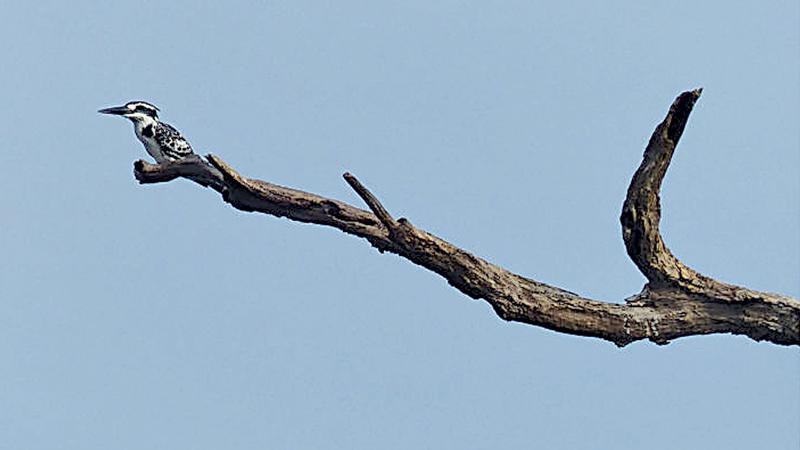
Between 1990 and 2020, 15% of the species of flora and fauna will become extinct” - UN
Environment has been man’s close friend in its timeless journey. Yet, man through his ignorance has made a crucial contribution to the destruction of the environment and this process of destruction has been undertaken very lightly, ostensibly to satisfy man’s basic needs.
Representatives of 115 countries got together decades ago at Rio de Janeiro in Brazil seeking to slow down this process of waste and destruction.
The historic Earth Summit attempted to analyze the harm caused by the developed countries to the environment and to identify a program through which the poorest of the poor of the Third World can use the environment to ensure their survival.
It has now become apparent that the strategy recommended by the First World to Asia is one which entails the speedy sell off of the natural resources of those Asian countries to the industrialized world. This ensured the near total destruction of the teak forests of Burma, the Sal and D’eodar forests of India.
Tropical zone
 Indonesia too sacrificed its land at the rate of a million hectares per year. If we in Sri Lanka do not take steps to come up with a responsible analysis on how this tragic situation affects our country, we will be committing a crime against future generations. So far, Sri Lanka has been just one more name on the list of those countries which meekly implemented the anti-environment strategy imposed on them by the rich countries.
Indonesia too sacrificed its land at the rate of a million hectares per year. If we in Sri Lanka do not take steps to come up with a responsible analysis on how this tragic situation affects our country, we will be committing a crime against future generations. So far, Sri Lanka has been just one more name on the list of those countries which meekly implemented the anti-environment strategy imposed on them by the rich countries.
Let us postpone any inquiry into how much longer the world will progress. Of the 30 million species of animals and fauna that scientists believe exist in the world, only 1.4 million have been positively identified by the 20th century. A great majority of them live in the developing countries of the tropical zone.
It is confirmed now that as a result of the present ‘progress’, living things are becoming extinct at a speed ten thousand times faster than man evolved. That is to say, 20,000 species are becoming extinct each year. In other words, because 15% of the living things in the entire world are in tropical forests, if the current trends continue unabated, it will take only 30 years for the annihilation of all those species.
Because Sri Lanka is a signatory to the convention on safeguarding the Earth, it is our duty as Sri Lankans to do what we can to prevent this wanton destruction of the environment.
Sri Lanka gained her political independence more than four decades ago. Yet, so far there has been no sincere and responsible attempt to implement a program of nature preservation.
At the UN Conference held in Stockholm, Sweden, a Swedish delegate told the world for the first time, about acid rain and about poisonous chemicals absorbed by birds and fish. As a result, environment became a subject of contention in both, the US and Canada. However, the United Nations did not have the opportunity to take any action to deal with this problem of the steady destruction of the environment.
The main reason for this might have been that the small states all over the world had been forced to adopt a peculiar way of life due to the Cold War.
Soon, population, Science and Technology, food, conversion of deserts into fertile land, etc., became topics for discussions at global level.
Today, there is a prosperous North and an impoverished South. Most of the third world countries belong to the impoverished South. This impoverishment was considered by the prosperous to be the natural order of things. Due to the prosperity of the North and the apparent happiness of the people there, (an impression conveyed by the international media controlled by the rich North) the poor people of the South began to regard the North as a paradise.
The North also succeeded instituting in the ruling class in the Southern countries capable of controlling the masses suffering from poverty and a low level of education.
The entire phenomenon was common to the entire SAARC region, Indonesia, India, Sri Lanka, Malaysia and the Philippines were among the countries which committed most errors.
The accepted theory was that it is better to hand over one’s resources to others and become dependent on them rather than using one’s own strength and resources to overcome poverty.
Accordingly, Indonesia felled trees on a million hectares per year and sold them to the developed world. The Philippines cleared the forest and planted cash crops for export.
Sri Lanka also built roads through the Singharaja Forest and allowed a developed country to exploit part of it.
Indonesia was exploited by America as a source of timber for production of paper and by Japan as a source of plywood. The residents of Jakarta who lived near a natural forest were sent off to another island and their birth place converted into a tourist centre for Americans.
Speed of destruction
By the beginning of the 70s India was deprived of all its Sal and D’eodar forests. In Sri Lanka, 30 million acres of land were devastated within 25 years. The natural forest cover in areas 8,000 feet high and where the annual rainfall is about 200 inches had been brought down to 80% by the last century. Due to the cultivation of potatoes the layer of soil in the Horton Plains was depleted by several inches.
It was in this period that the Food and Agriculture Organization (FAO) pointed out that the speed of destruction of tropical forests had increased by 50%, thus the people of the world losing 17 million hectares of land every year. The fact that a million families were settled in the Amazon basin and that as much as 10% of the forest was destroyed by 1980, symbolized the on going tragedy.
 Many poor countries have by now realized that their resources are being deceitfully exploited by the developed countries. A delegate from a poor country said recently, the United Nations should not give any support to the rich countries exploiting Southern resources.
Many poor countries have by now realized that their resources are being deceitfully exploited by the developed countries. A delegate from a poor country said recently, the United Nations should not give any support to the rich countries exploiting Southern resources.
Already, cities like Sevesso, Louisville, Michigan, Camdon and Bridesberg are being devastated by pesticides and chemical waste. It was reported in May 2013, the imported sugar and fruits to Sri Lanka were infected with toxic cadmium.
“Not only the Cold War, but the first generation of the UN too is now over” Bedrich Molden, chairman of the committee on institutional problems once said at a meeting, “These ideas which came into being with the end of the second World War must be changed now.
The main challenges: What we have to face now are environment and development, poverty, prevention of North – South conflict, etc.”
The former Secretary General of UN said, ‘the United Nations Organisation came into being not just to settle disputes between various parties but to discover hidden abilities of different groups of people and direct these towards development.
The delegate generally agreed that the UN also was responsible to some extent for the present sad state of the environment. Whether a new front must be formed within the UN to deal with the questions of the development and environment or not, is the next issue that would have to be decided.
The European Economic Community, Canada and the former Soviet Union, and the ‘77’ group of developing countries appear to be lethargic or indifferent to this matter. Another necessity would be to secure funds for the organizations active in this field and work out policies.
The poor countries of the South have now lost confidence in institutions such as the World Bank which act on the basis of principles like “one dollar for one vote.”
According to the UN sources, the number of the poorest of the poor in the developing world exceeds a billion. These people do not have the means to obtain the minimum amount of food required to avoid malnutrition. Of these, 64% live in Asia, 24% in Africa and 12% in Latin America and the Caribbean Island. The UN says, in order to save these people from the magnitude of their poverty, the reasons why the poor children are indifferent to education, the condition of health services, and availability of pure water and sanitary facilities must be inquired into and understood. According to the data made available by the UN, about 1-5 billion people in the developing world do not have proper health facilities. Nearly 1.75 billion do not have uncontaminated water and 2.8 billion have no sanitary facilities. In the developing world, 870 million adults are illiterate. About 150 million babies suffer from malnutrition and 240 million children are vagrants.
According to the UN publication, the reason for their failure to escape poverty and their permanent refugee status is that a majority of them have settled in barren infertile areas.
Venezuela’s opinion was that, “the North is concerned about the growth of population in the South.” The population can be brought down only by economic relief and by raising the standard of education. It is obvious, this problem must be solved in accordance with practical human needs, for which immediate transfer of technological knowledge and intellectual property to the South is necessary. This could perhaps remain a dream until there emerges a society in the North, happy to see the people of the South using the resources of the South the way they want, for their own benefits.
Haphazard journey
The freedom about production processes is where the Third world needs the freedom to choose their own economic strategy as well as economic concession. Yet, about 80% of the institutions responsible for the supply of goods and services required by the Third world are controlled by multinationals attached to the US, England, Germany and Switzerland. Sri Lanka too gets its requirements of milk powder, infant foods, detergents, sugar, medicines, textiles, footwear, sanitary goods, telephone services etc., through such multinationals. Even though countries like Uganda, Vietnam, Malaysia and Myanmar are not super brand countries in the world map, the island nation is now depending on many vital issues from them.
When we look back at the haphazard journey we have made in regard to several problems, it is doubtful whether Sri Lanka had paid sufficient attention to the question of population and development.
Even a decade ago, 30% of the 272,500 residents of Colombo were without basic sanitary facilities. About 52% of them had pipe – borne water while the others had to use wells. As many as 10% used unclean river water or unclean well water. At least 5% from each home, or 150,000 persons in the Colombo district were infected with water borne diseases. The position is still worse in the Gampaha district.
Only 5% of the rural population has pipe borne water, and as many as 85% used wells and rivers in the Hambantota, Moneragala and Matale districts, 30-40% of the wells have no protection. The people of Moneragala and Hambantota areas almost entirely depend on water from tanks, ponds and rivers.
In Senegal, recently, there was great unrest and street protests due to the privatization of drinking water. Even a glass of drinking water had to be paid for, and about 300,000 people in the rural areas of Doha had to fight against the national company to obtain drinking water. Instead of changing its stand, the ruling class is getting ready to separate 96,000 public wells and 21,000 wells where water has to be paid for.
A major factor that affects water is the soil. Almost 1/3 of Sri Lanka land area is subject to the annual upturning of the soil. The Sri Lankan cultivators use fertiliser 7 times more than in other countries of the region. This amounts to 124 Kgs per hectare.
The pollution caused by fertilizer leads to a dilemma. Due to the havoc caused by nitrates (N2) to the traditional patterns of agriculture in Jaffna and N’Eliya expectation regarding soil and surface – water were destroyed. Excess nitrate leads to intestinal disorders in children. Another area endangered by the application of fertilizer is the Moneragala district were sugar cane cultivation has absorbed more than 25,000 hectares. The result of this can be seen in the state of the seven rivers flowing through Moneragala.
Pesticides are used mainly in paddy cultivation. The amount of pesticides used went up by 1,200 to more than 1,600 grams in the last decade. The Sri Lankan cultivators are in the habit of using twice the amount prescribed.
According to the UN, between 1990 and 2020, 15% of the species of flora and fauna will become extinct.
Troubled by these forecasts the rich countries are using their management skills and scientific knowledge to discover the environmental heritage of the South.
Although their efforts may be considered beneficial in the long term, at present it amounts to “stealing of resources at a time when the people of the Third world are struggling for survival. While these rich countries pay attention to the environment and survival, they also take care to renew a situation which will promote racism, war and political conflict. Is it possible to heal environmental wounds of the Third world by the reforms proposed by the North? When the aims and the characters of non-government organizations which wear various masks are studied it is obvious they seek to serve only their own interests. They are not interested in the welfare of developing countries.
Existing resources
If we are to save the existing resources of Sri Lanka it is necessary to have a proper understanding about them.
The land commission says, 2 million hectares on nearly 5 million acres of (rain fed) land in the dry zone are ready for agriculture, or other developmental purposes. (At present much of it is in the hands of the government and Wildlife Departments). The wet zone forests have reduced to below 10% now. However, Sri Lanka has the distinction of having the most valuable forests in South Asia. (The next best rainforests are in Madagascar and Sumatra) Yala and Wilpattuwa which are two of Sri Lanka’s largest National Parks are found in areas where agriculture is debarred.
As a percentage, Sri Lanka still has a reasonable area of forests by Asian standard. It is 25% of the total area of the country. However, this is not land that has been left with the country’s genuine welfare at heart. It is said, some of these forest lands are very good for agriculture. The forests in the wet zones are used for lakes, fuel (firewood) and to meet their food requirement. Even this view is expressed more by foreign organisations.

